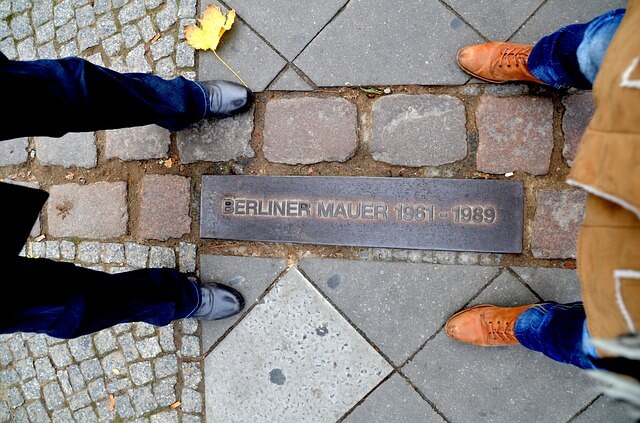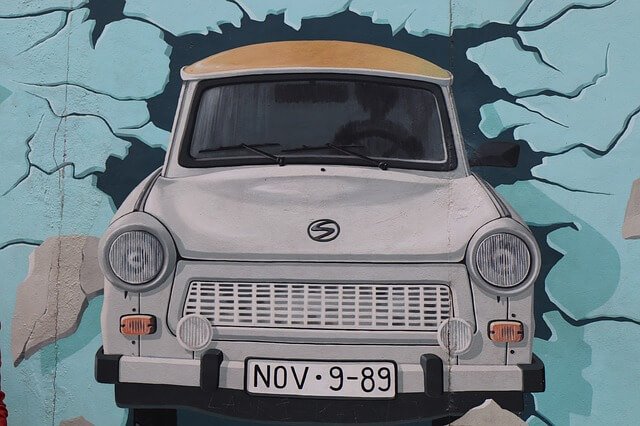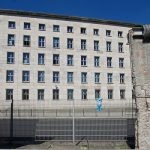 After the borders of the Soviet zone were initially guarded only by the Red Army, a paramilitary police unit was set up for this task on 1 December 1946. Initially simply called the Border Police, it was renamed the German Border Police in May 1952. From May 1952 to June 1953, it was directly subordinate to the Ministry for State Security (MfS), before and after that to the Ministry of the Interior.
After the borders of the Soviet zone were initially guarded only by the Red Army, a paramilitary police unit was set up for this task on 1 December 1946. Initially simply called the Border Police, it was renamed the German Border Police in May 1952. From May 1952 to June 1953, it was directly subordinate to the Ministry for State Security (MfS), before and after that to the Ministry of the Interior.
After the Wall was built, on 15 September 1961 it was subordinated to the Ministry of National Defence as the Border Command. The units that carried out the identity checks at the checkpoints were subordinate to Department VI of the MfS under the name Passport Control Units (PKE).
These men and women, with whom the transit traveller or tourist had direct contact, thus belonged to the Stasi.
The introduction of compulsory military service in the GDR in April 1962 meant that from then on conscripts also served in the border troops. To emphasise the military character, military border regiments were formed in October of that year.
Until 1971 they belonged to the NVA, but now they were officially hived off in order to trick the disarmament negotiations with regard to troop numbers. In practice, they were now an independent branch of the armed forces, directly subordinate to the Ministry of National Defence.
By the 1980s, the border troops had reached a strength of 44,000.
In GDR propaganda, they were portrayed as an elite force that was essential for the preservation of peace and the state. Just as the Wall was glorified as an “anti-fascist protective wall”, the people’s prison guards were celebrated as heroes. 1 December was celebrated as the “Day of the Border Troops”. But despite all the propaganda, there were not enough volunteers for the border troops.
Service with them was not attractive. The housing provided by the state for families was poor and the income was not high. Even an officer’s career was not promising. As in all sectors of the GDR, chances of promotion were directly related to political reliability. Thus, over 90% of officers were party members and even outside the PKE, over 20% of border guards were members of the state security.

Unlike the PKE, the majority of the guards at the Wall were conscripts.
It is interesting that the former border guards today, with few exceptions, see themselves as completely normal soldiers. (Similar to the members of the Waffen SS after 45). But did they have no choice? The professional soldiers of the border troops all served voluntarily and none of them can claim not to have known about the shots at the Wall (firing order). To this day, those responsible deny the existence of the firing order, just as Wehrmacht leaders denied the Commissar’s order after 45. In addition to the available documents, there are numerous eyewitness testimonies that prove that the order was mentioned among the troops.
However, it was not quite that simple. During training, the contemporary witness Andreas Weiß had answered the question: “Why do we do border duty?”: “That we are to prevent GDR refugees from crossing the border with a firearm if necessary.”
The correct answer would have been: “We have to prevent border breaches from West to East and other acts of sabotage by West German reactionaries. GDR refugees are criminals. They would be turned in by the police or border guards in the hinterland.” He got a 5 in politics class.
And the conscripts? Typical are the statements of Frank Pergande, later political correspondent for the Frankfurter Allgemeine Sonntagszeitung in Berlin: “I couldn’t help being drawn to the border in basic military service.” He then goes on to say that anyone who wanted to study had to do military service. If possible with a commitment for 18 more months after basic military service.
As a citizen of the GDR, however, you could legally refuse to do military service with a weapon. But you couldn’t study or make a great career as a soldier. So it was simple opportunism that led the young men to the border. And not all conscripted border guards had A-levels.
But it was by no means the case that all border guards were 100 per cent supporters of the GDR. On the contrary, hardly any group of the population was as closely monitored by the Stasi as the border guards. They patrolled the border area in pairs. In the top-secret planning of posts by superiors, care was always taken to ensure that one of the pair was above reproach. Only immediately before going on duty did the soldier find out with whom he would be on duty. But since the group only had nine soldiers, this was not a very effective measure. The men were divided by the MfS into three groups: “core (positive part of the collective), reserve (wavering and unclear), and rest (inhibiting and negative)”. The border guards themselves spoke of the “different blood groups”.
In the first six months of service, the conscript had to complete basic training. Political instruction was taken particularly seriously.
Once at the border, the conscript quickly realised how far apart propaganda and reality were. Instead of protecting the GDR against external enemies, they were deployed to prevent their own people from fleeing.
The barracks were typically military and spartan, and daily duty was boring. In addition, there was mistrust of one’s comrades. Anyone could be a Stasi informer. Contrary to the official GDR attitude towards the border guards, they were not popular among the population. So the conscripts wore as little uniform as possible when they went out.
Frustration spread and some of them shirked their duty as much as possible. It is not uncommon to find entries in the surviving service records such as: “He was found sleeping in the post office tower. This was not without risk; according to investigations by the Stasi, the two border guards shot by NVA deserter Werner Weidenhold were probably killed in their sleep.
On the other hand, the punishments for offences were not high; if you were caught, you were banned from taking leave or had to spend a few days in prison.
Duty was divided into three shifts: eight hours of border duty, then eight hours of standby duty and then eight hours of sleep.
Strict rules applied at the border, and failure to comply with them was punished. There was a ban on smoking and talking, and separation from one’s partner was forbidden,
Of course, contact with West Germans was forbidden. You had to keep out of sight as much as possible so that you would not be seen from the “enemy side”. A typical order of the day read: “Post with post leader deployed (location given) with the task of tracking down and destroying border violators.”
The orders stipulated that the slogan of the day was to be asked during encounters. If there was no correct answer, the order was to shoot (!). It was better to fire a well-aimed shot than a warning shot or a missed shot. Time and again, accidents occurred in which border guards shot at other guards.
The monotonous service and the unpleasant climate of interpersonal relations led to a number of suicides.
The contemporary witness Weiß reports; “Our company consisted of four platoons. Each platoon had ten soldiers and a platoon leader with the rank of a lower officer or professional soldier. The platoon leaders had the worst rank. They were kicked from above and constantly had to deal with the soldiers’ rebelliousness. At the border, I myself experienced how a platoon leader of our company shot himself with a Kalashnikov. It was a non-commissioned officer who could no longer stand the psychological pressure.”
In addition to the fear of the Stasi informers, there was also the fear of the comrade who might be planning an escape.
Between 1977 and 1986, 107 members of the border troops fled to West Germany (90) and West Berlin (17). 69 of them were crew members. The reinforcement of the border installations in the 1980s was not primarily directed against civilian refugees, but against the border guards themselves. In the first years, until 1970, over 1500 border guards had fled. Due to the more difficult conditions, the number of escapes among border guards dropped to an average of 10 per year.
Those who seemed particularly reliable could serve with the Border Brigade Coast. Or even serve on one of the boats that navigated Berlin’s wet border. The boat crews were under close observation.
To increase this reliability, the state relied on propaganda. In any case, only conscripts whose parents had no relatives in West Berlin or the Federal Republic were deployed at the border.
In addition to guarding the Wall, the units also had an offensive task. Border Regiment 33 (responsible for 23.7 kilometres north of the Brandenburg Gate) prepared the occupation of West Berlin in the event of a conflict.
The border troops were disbanded by “Order No. 49/90 of the Minister for Disarmament and Defence on the Disbandment of the Border Troops of the GDR” on 30 September 1990, about 15,000 members were dismissed. Some of the professional soldiers were transferred to the Federal Border Guard (BGS, now the Federal Police). 4,500 worked for the Bundeswehr’s Reclamation Command on dismantling the inner-German border barriers.
Many concealed their affiliation with the MfS. For years, there were repeated cases of members of the BGS being dismissed for this reason.



